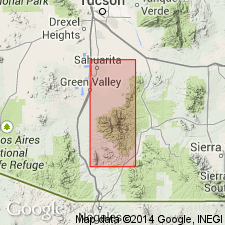
- Usage in publication:
-
- Mount Wrightson Formation*
- Modifications:
-
- Named
- Geochronologic dating
- Dominant lithology:
-
- Sandstone
- Rhyolite
- Andesite
- Latite
- AAPG geologic province:
-
- Basin-and-Range province
Summary:
Named. Type area includes a stretch along trail between Madera and Gardner Canyons and north slope of Cave Creek Canyon in Santa Rita Mountains, Santa Cruz Co, AZ, Mount Wrightson quad. Underlies crest and upper part, east flank, Santa Rita Mountains. Is at least 8,500 ft thick. Lowest member, 1,500 ft thick, is made us mostly of dacitic to andesitic rocks but also includes some rhyolitic rocks and intercalated thin lenses of quartzite and sandstone. Some of the andesites are amygdaloidal and vesicular, others are porphyritic. Middle member, about 5,000 ft thick, is mostly well-indurated, grayish-red, finely flow laminated and porphyritic rhyolite and latite but includes dacitic volcanics, welded tuffs, flow and tuff breccias present locally. Lenses of sandstone, quartzite, and conglomerate present. Upper member, 2,000 ft thick, contains andesitic (pillow lavas and amygdaloidal flows) and rhyolitic volcanics and eolian sandstone. Base is intruded everywhere and top is everywhere a fault contact. Zircon from middle member was dated by Pb alpha method as 220 +/-30 m.y. Is assigned a Triassic age.
Source: GNU records (USGS DDS-6; Denver GNULEX).
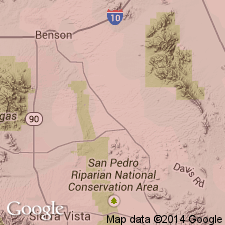
- Usage in publication:
-
- Mount Wrightson Formation*
- Modifications:
-
- Areal extent
Summary:
Mount Wrightson Formation is geographically extended into the Patagonia Mountains, Santa Cruz Co., AZ.
Source: GNU records (USGS DDS-6; Menlo GNULEX).
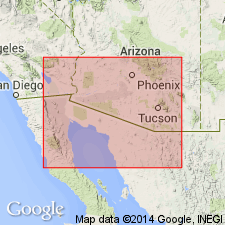
- Usage in publication:
-
- Mount Wrightson Formation*
- Modifications:
-
- Age modified
- AAPG geologic province:
-
- Basin-and-Range province
Summary:
Considered to be late Early to early Middle Jurassic based on U-Pb isotopic ages. Is distinctly younger than Chinle Formation and a correlative of upper part of Navajo Sandstone. Middle Jurassic age assignment based on placement of Aalenian as the basal stage of the middle Jurassic between the lower Jurassic Toarcian Stage and the Middle Jurassic Bajocian Stage. [Some authors follow Imlay (1980) in that they do not recognize the Aalenian Stage, and they place the Lower-Middle Jurassic boundary between the Toarcian and the Bajocian.] Known in Basin-and-Range province.
Source: GNU records (USGS DDS-6; Denver GNULEX).
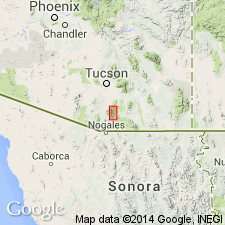
- Usage in publication:
-
- Mount Wrightson Formation*
- Modifications:
-
- Geochronologic dating
- AAPG geologic province:
-
- Basin-and-Range province
Summary:
Lower member of Mount Wrightson Formation has an imprecise maximum age of about 220 Ma from andesite near middle of member. Lower member and base of middle member of Mount Wrightson cut by Piper Gulch Monzonite which has a concordant zircon U-Th-Pb age of 188 +/-2 Ma. Zircon from a rhyolite in middle member of Mount Wrightson gave an age between 172 and 192 Ma. A hiatus of no longer than 30 m.y. is thought to separate the lower and middle members. This break marks a change from early dominantly basaltic and andesitic volcanism to later dacitic to rhyolitic lavas and tuffs. The middle member-Piper Gulch contact is marked at one locality by a chilling zone, and signs of baking and alteration. At other localities, the middle member-Piper Gulch contact seems to be depositional. Upper member of Mount Wrightson not sampled. Felsic rocks of the middle and upper members of the Mount Wrightson, the Canelo Hills Volcanics, Ox Frame Volcanics, and Ali Molina Formation are equivalent. Study area in southern AZ is in the Basin-and-Range province.
Source: GNU records (USGS DDS-6; Denver GNULEX).
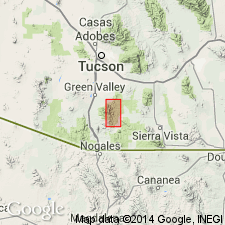
- Usage in publication:
-
- Mount Wrightson Formation
- Modifications:
-
- Age modified
- Geochronologic dating
- Overview
- AAPG geologic province:
-
- Basin-and-Range province
Summary:
Age is 212-181 Ma based on U-Pb zircon analyses by various workers, including senior author. Entire formation accumulated within less than 10 m.y. Eolian quartz arenite in Mount Wrightson correlates with either Wingate Sandstone and/or Navajo Formation on Colorado Plateau. Geologic maps; measured sections. Mount Wrightson represents a multi-vent volcanic complex that formed during Early Jurassic time within a subsiding cratonal intra-arc graben.
Source: GNU records (USGS DDS-6; Denver GNULEX).

- Usage in publication:
-
- Mount Wrightson Formation
- Modifications:
-
- Geochronologic dating
- AAPG geologic province:
-
- Basin-and-Range province
Summary:
New U-Pb zircon data in Santa Rita Mountains, Pima and Santa Cruz Cos, AZ, Basin-and-Range province, yield ages of 190-170 Ma (Pliensbachian to Bajocian, Late Jurassic). Thus deposition of Mount Wrightson spanned about 20 m.y. and is age equivalent to Kayenta Formation and Navajo (and equivalent Aztec) and Temple Cap Sandstones. Generalized stratigraphic chart (fig. 11).
Source: GNU records (USGS DDS-6; Denver GNULEX).
For more information, please contact Nancy Stamm, Geologic Names Committee Secretary.
Asterisk (*) indicates published by U.S. Geological Survey authors.
"No current usage" (†) implies that a name has been abandoned or has fallen into disuse. Former usage and, if known, replacement name given in parentheses ( ).
Slash (/) indicates name conflicts with nomenclatural guidelines (CSN, 1933; ACSN, 1961, 1970; NACSN, 1983, 2005, 2021). May be explained within brackets ([ ]).

